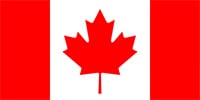Drone Laws in Canada
Drone regulations and links for people flying drones in Canada.
 Canada Drone Regulations
Canada Drone Regulations
According to Canada’s national aviation authority, Transport Canada Civil Aviation (TCCA), flying a drone is legal in Canada, but we recommend being aware of and compliant with the drone regulations listed below before doing so.
If you’d like to contact TCCA directly before you travel with any questions you might have, here is their contact information: services@tc.gc.ca / +1 800 305 2059

Why fly a drone in Canada? To get great aerial shots like these!
General Rules for Flying a Drone in Canada
Notice: Canada is currently not accepting SFOC applications from visitors that are looking to fly their drone recreationally. This does not apply to visitors who are requesting an SFOC for commercial operations. This temporary restriction will be re-evaluated in January 2021. More information on this topic can be found on this page.
The following rules apply to all drone operations:
- All drones that weigh between 250 g and 25 kg must be registered with Transport Canada. Pilots must mark their drones with their registration number before they fly.
- All pilots of drones that weigh between 250 g and 25 kg must get a drone pilot certificate.
- Fly your drone where you can see it at all times
- Fly below 122 meters (400 feet) in the air
- Fly away from bystanders, at a minimum distance of 30 meters for basic operations
- Do not fly at the site of emergency operations or advertised events
- Avoid forest fires, outdoor concerts, and parades
- Do not fly within 5.6 kilometres (3 nautical miles) from airports or 1.9 kilometres (1 nautical mile) from heliports
- Fly far away from other aircraft
- Do not fly anywhere near airplanes, helicopters, and other drones
- Always respect the privacy of others while flying
Additional rules apply depending on your type of operation. The rules introduce two categories of drones operations: basic and advanced. The categories are based on distance from bystanders and on airspace rules.
Determine if Your Drone Operations are Basic or Advanced
If you meet all three of these conditions, you’re conducting basic operations:
- You fly your drone in uncontrolled airspace
- You fly your drone more than 30 metres (100 feet) horizontally from bystanders
- You never fly your drone over bystanders
If you do not meet any one of these three conditions, you are conducting advanced operations.
If you meet any one of these conditions, you are conducting advanced operations:
- You want to fly in controlled airspace
- You want to fly over bystanders
- You want to fly within 30 meters (100 feet) of bystanders (measured horizontally)
Rules for Basic Drone Operations
In addition to the general rules for flying a drone in Canada, pilots conducting basic drone operations must:
- Pilots conducting basic operations need a Pilot Certificate – Basic Operations
- Be able to show your Pilot Certificate – Basic Operations and proof of registration when you fly
Rules for Advanced Drone Operations
In addition to the general rules for flying a drone in Canada, pilots conducting advanced drone operations must:
- Pilots conducting advanced operations need a Pilot Certificate – Advanced Operations. To get this certificate, they must pass the Small Advanced Exam and an in-person flight review. The flight review will assess a pilot’s ability to operate their drone safely.
- Fly with a drone that meets RPAS Safety Assurance standards. A list of drone manufacturers and models rated to be approved for certain advanced operations can be found here.
- Survey the area where you will fly. Take note of any obstacles, such as buildings and power lines.
No Drone Zones
“No drone zones” are areas where it may be unsafe or illegal to fly your drone. When you fly a drone for any reason you should generally not fly:
- around airports and aerodromes
- in busy, populated areas
- in national parks
- over border crossings
You can only fly your drone in these areas for specific purposes by getting permission from Transport Canada. For more information on “no drone zones,” see this page on the TCAA website.
For more information on Canada’s drone laws, see this page on the TCAA website.
Know something we don’t about drone laws in Canada? Send us an email at support[at]uavcoach[dot]com. We are not international aviation attorneys and do our best to keep this page up-to-date for drone pilots, but the reality is that given the pace of the small unmanned aerial system (sUAS) industry and how governments are responding, drone regulations in Canada can change throughout the year, and those changes can be hard to track. If we missed something, please reach out to let us know.
Want to get a feel for the kind of footage you could get flying a drone in Canada? Here you go:
 Canada Drone Regulations
Canada Drone Regulations